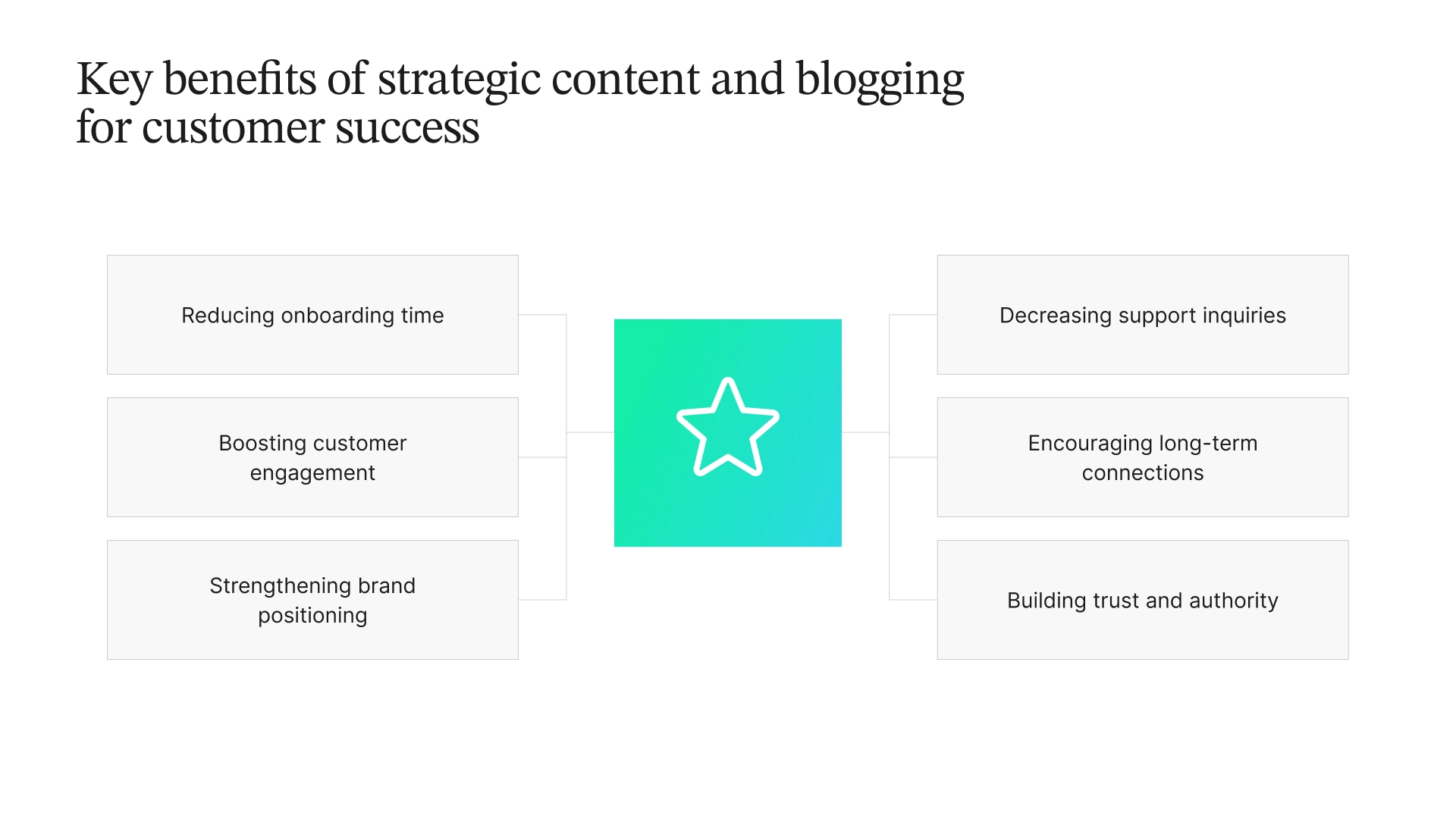Content and blogging have been a mainstay for SEO and user engagement for as long as the internet existed. However, the concept of using blogging and other content types in your customer success strategy is relatively novel.
While businesses try to improve their customer support by training their staff and making their jobs easier with automation, many seem to underestimate the power of content for customer success.
In this article, we are going to look at the eight types of content you can use for customer success, as well as some tips for making it useful.
8 Best Types of Content for Customer Success
There are many ways to do customer success marketing. These are the most common ones, but you can always come up with new and creative ways to improve the experience of your clients.

Guides and tutorials
Guides and tutorials are key to helping customers familiarize themselves with your product or service. These step-by-step instructions can cover everything from basic setup to advanced features, ensuring that users can make the most of what you offer.
They can be done in text or video and placed on your blog, video channel, social media, and other channels. You can also write guides as guest posts for other products and sneak in promotions of your own.
Make sure all your guides are comprehensive, easily shareable, and can be updated without too much hassle. As time goes on, don’t forget to make changes to your guides and monitor published content regularly to keep them up-to-date.
Don’t neglect accepting guest post submissions from other popular industry blogs. While it may be someone else’s content, it’s still quality content for your website. If people see you collaborating with authoritative experts, they will also associate you with them and view your website as more trustworthy.
Key benefits:
- Reduces the learning curve for new users
- Decreases support ticket volume
- Lets customers solve problems independently
Tips and best practices
As Liquid Learning rightfully points out, thought leadership is vital for marketing today. It helps establish your authority as an industry expert. Sharing tips and best practices also helps customers optimize their use of your product or service. This type of content can range from quick productivity hacks to in-depth strategies for achieving specific outcomes.
If you want this content to truly shine, support it with real data and statistics, and include actionable recommendations instead of vague “do good, don’t do bad.”
Key benefits:
- Improves customer efficiency and satisfaction
- Showcases the full potential of your offering
- Positions your brand as an industry expert
Case studies and testimonials
Case studies and testimonials show real-world applications and successes of your product or service. By using customer success stories, you provide social proof and inspire others to achieve similar results. For instance, a business implementing a courier service could highlight how faster delivery improved customer satisfaction.
Key benefits:
- Builds trust and credibility
- Illustrates practical applications of your offering
- Helps potential customers envision their own success
Workshops, webinars, and courses
Workshops, webinars, and courses are a great way to connect and interact with your audience. Not only does it allow you to answer questions of your real customers, but you also receive live input on what they value.
For them to succeed, make sure you have polls and Q&As, invite other industry specialists, and use visual aids to better make your points. You can also offer certificates that confirm participation in a workshop. This is self-explanatory for courses, but workshops and webinars can also be divided into a series of regular meetings if there is a lot to cover.
Key benefits:
- Facilitates direct interaction with customers
- Creates a sense of community among users
- Can be a valuable upsell or premium offering
FAQs
Frequently Asked Questions are exactly that—answers to questions your customers frequently have. Having them answered immediately will save your customer support agents a lot of time.
Many SEOs and writers neglect FAQs or use them as keyword dumps. Don’t do that. It’s fine to insert keywords in your FAQs, but using them specifically for that is a terrible practice that will only lead to more confusion for your users.
To make this content more engaging, make sure you use a friendly tone, answer real questions from your users, and give factual information without fluff.
Key benefits:
- Reduces support workload
- Improves customer self-service capabilities
- Can be easily updated based on emerging issues
Newsletters
Regular newsletters keep your audience informed about product updates, industry news, and helpful tips. Make sure your emails give users unique insights, not just general information.
For a bigger impact, segment your audience to ensure you serve tailored and curated content to different groups. This significantly boosts engagement and makes for a happier customer base.
Key benefits:
- Maintains ongoing engagement with customers
- Drives traffic to other content resources
- Provides a platform for announcements and promotions
- Ensures a clean, verified email list so you connect only with engaged, active contacts
Social media posts
Using social media allows you to share short-form content and engage with customers on platforms they frequently use. This can include quick tips, product highlights, or links to learn more about your product or service.
Every platform requires a different approach. What works for Instagram Carousel might be too slow or conservative for TikTok shorts, but what works for TikTok might be too fast and not detailed enough for Facebook post. That’s why there’s an option to tailor your content and even add Facebook feed to your website to maintain consistency and engagement across platforms.
Social media are very visually oriented, so make sure you have visuals to support your posts. Adorn your content with high-quality images, infographics, and even event graphics to highlight promotions or special occasions. Using a photo editing tool can help you enhance your images, making them more eye-catching and professional-looking. Don’t forget to use hashtags on platforms that support them. You might find them weird or silly, but they work, and that’s what matters.
Key benefits:
- Increases visibility and reach
- Encourages community interaction and sharing
- Allows for real-time customer support and feedback
User-generated content
User-generated content (UGC) is incredibly powerful, as most people trust other customers more than any promotion from you. Encourage people to create content using your product or service and share it on social media. This loops back to your social media campaigns and also improves your credibility.
There are many ways to encourage customer content. You can create a time-limited campaign or ask people to share all the time. Whichever you choose, make sure to offer incentives and reward top creators the most.
You can also create a separate platform for users to share their content with others interested in that kind of thing. This allows for finer control over the content, though it requires more resources, and some choose to work with a UGC agency to support the process.
Key benefits:
- Builds authenticity and trust
- Provides diverse perspectives on your offering
- Fosters a sense of community among users
Takeaways
By implementing a broad range of content types, you create a strong ecosystem that supports your customers at every stage of their journey. The key to successful content creation lies in understanding your audience, providing genuine value, and consistently delivering high-quality information.
As you move forward, don’t be afraid to experiment with different content formats and strategies. Pay attention to your analytics, gather feedback from your users, and continuously refine your approach.
By investing in content that educates, engages, and supports your customers, you’re not just improving their experience; you’re building lasting relationships, enhancing brand loyalty, and creating the groundwork for long-term success. Remember, when your customers succeed, your business thrives.











